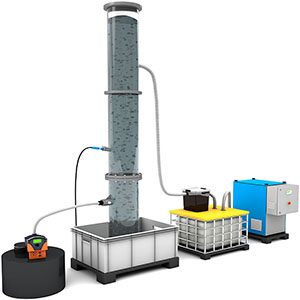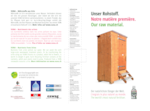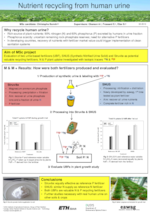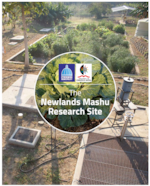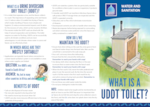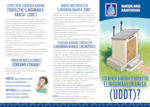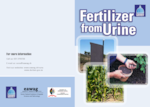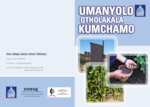Département Technologie des procédés
Projet VUNA – Récupération de nutriments des urines
Bienvenue sur le site du projet de recherche VUNA (2010-2015). En 2016, la spin-off Vuna Sàrl à été céée : www.vuna.ch
L'objectif du projet VUNA a été de récupérer les nutriments contenus dans les urines, en développant un système sanitaire, qui produit des engrais, encourage l'entrepreneuriat et réduit la pollution des ressources en eau. Durée du projet : 2010 à 2015.
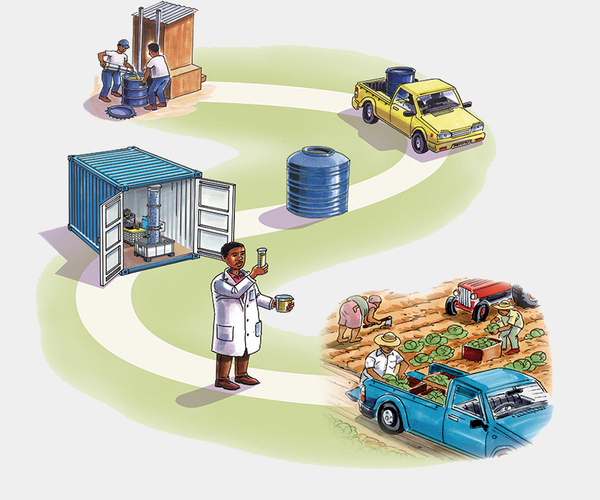
Recherche dans le cadre du projet VUNA
Dans le cadre du projet VUNA, nous étudions les sujets de recherche suivants. Pour en savoir plus, veuillez télécharger le Rapport final VUNA 2015.
Procédés de récupération de nutriments des urines
Notre corps excrète la majorité des nutriments à travers l'urine. En collectant l'urine séparément, nous pouvons récupérer des précieux nutriments, tels l'azote, le phosphore ou le potassium. Au même temps, nous évitons ainsi une pollution des eaux par une charge de nutriments trop importante.
VUNA installations pilotes de récupération de nutriments
Bâtiment principal Eawag :
Forum Chriesbach
Municipalité eThekwini :
Centre acceuil client-e-s
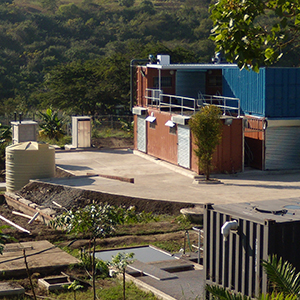
Terrain d'essais :
Newlands-Mashu
VUNA technologies de récupération de nutriments
Risques associés à l'utilisation d'urines
Urine and Fertiliser Quality
The foremost goals of urine treatment are the recovery of nutrients for beneficial use. However, the urine treatment processes must also ensure that the end-products are safe to use, provide adequate human and environmental health protection, and are of adequate quality to ensure optimal market value. Pathogens and pharmaceuticals could potentially impact the quality of end products.
Research activities:
- Removing pharmaceuticals: The majority of pharmaceutical residues are excreted in the urine (and not the faeces). Hence, the separate collection of urine isolates pharmaceuticals and prevents them from entering the environment. Experiments showed that long-term storage is not sufficient to remove pharmaceuticals. Nevertheless, processes occurring during nitrification, are suitable to remove certain pharmaceuticals. Virtually all pharmaceuticals can be removed in an activated carbon filter.
- Inactivating pathogens: Whereas some pathogens can be excreted in the urine, others are introduced from cross-contamination with faeces during urine collection. We evaluated the viability of representative pathogens during urine treatment. We observed partial disinfection through urine storage and nitrification. Distillation is assumed to eliminate all pathogens due to high temperatures. Research partner: Environmental Chemistry Laboratory at EPFL.
Engrais à base d'urines et aspect agricoles
Essais d'engrais avec des produits VUNA
Dans le cadre de projets partenaires, nous avons testé nous engrais en Afrique du Sud et en Suisse. À l' UKZN Agricultural Engineering Department à Pietermaritzburg, des expert-e-s ont fertilisé du maize avec de la struvite, des boues fécales séchées granulées et du superphosphate commercial.
À l'EPF Zurich, le Groupe de la nutrition des plantes a produit de la struvite et du concentré issu de la nitrification/distillation marqués avec des isotopes. Les tests de l'EPF sous serre ont démontré que les plantes assimilent les nutriments des produits VUNA aussi efficacement que des engrais commerciaux.
En 2015, l' Office fédéral de l'agriculture (OFAG) a octroyé une autorisation pour :
L'engrais liquide Aurin
Réseaux de collecte d'urines
eThekwini Water and Sanitation introduced urine-diverting toilets as a system to supply sanitation to unserved regions, where water is scarce and water-borne sewer systems are too costly. Therefore a cost-efficient and optimised urine collection approach is necessary to harvest the valuable nutrients in urine.
Research activities:
- Optimising urine collection: We aim to make urine collection more cost efficient. Therefore, we implemented a pilot urine collection scheme to gain experiences and suggest improvements. Based on the evaluated costs, we are currently developing a business plan.
- Performance Modelling: The entire system of urine collection, transport and decentralised treatment consists of a large number of interconnected elements (e.g. toilets, storage tanks, treatment reactors) which influence the overall system performance (e.g. pollution control, urban hygiene, fertilizer production). Using a combination of system analysis and mathematical modelling we identified critical elements, evaluated the value of particular measurement schemes and estimated the overall system performance.
Aspects sociaux et économiques
The success of any sanitation programme depends on people's willingness to accept it. Urine-diverting toilets are still not well accepted by many. In order to increase acceptance, health and hygiene education is needed.
Research activities:
- Social acceptance: We accompanied the introduction of the VUNA technologies with studies, which investigated the socio-cultural perceptions and factors influencing users’ acceptance.
- Campaigning for health & hyigene: Based on our findings from the acceptance studies, we developed appropriate educational activities and awareness material, e.g. for households and schools.
- Incentives for urine production: By giving urine a financial value, we tested how to increase toilet use, improve hygiene, reduce loss of valuable nutrients and augment household income for the poorest.
- Business model: To better understand the value chain from urine to fertiliser, we analysed the various components of the nutrient recovery system from a business perspective.
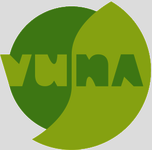
À propos de VUNA
Acronyme, nom de projet et devise à la fois, le mot "VUNA" représente la valorisation des nutriments des urines en Afrique (Valorisation of Urine Nutrients in Africa). En zoulou, la langue parlée à Durban, le mot "vuna" veut dire "récolte". La récolte sera abondante, si les cultures jouissent d'un régime nutritif équilibré. Dans le cas du projet VUNA, nous récoltons les nutriments à partir des urines.
Collaboratrices et collaborateurs
Comité directeur
Chefs de projet
Coordinateur de projet
Procédés de récupération de nutriments
- Récupération complète: Bastian Etter, Alexandra Fumasoli, Bettina Sterkele, Kai M. Udert, Lungiswa Zuma, Chris Buckley, Chris Brouckaert, Mlungisi Mthembu
- Nitrification: Alexandra Fumasoli, Bastian Etter, Bettina Sterkele, Kai M. Udert, Eberhard Morgenroth
- Distillation: Bastian Etter, Kai M. Udert
- Electrolyse: Hanspeter Zöllig, Eberhard Morgenroth, Kai M. Udert
- Struvite: Lungiswa Zuma, Chris Buckley, Chris Brouckaert
- Contrôle de procédés: Kris Villez, Alma Mašić, Christian Thürlimann
Risques associés à l'utilisation d'urines
- Pathogènes: Loïc Decrey, Tamar Kohn, Heather Bischel
- Résidus de médicaments: Christa McArdell, Kai M. Udert
Agriculture
- Essais de fertilisants: Astrid Oberson, Christophe Bonvin, Emmanuel Frossard, Simone Nanzer, Alfred Odindo, Irene Bame, William Musazura
Réseaux de collecte d'urines
- Collecte d'urines: Teddy Gounden, Hope Joseph, Kevyn Govender, Scelo Xulu
- Modélisation de performance: Max Maurer
Aspects sociaux et économiques
- Acceptation sociale: Lisa Frost Ramsay, Scelo Xulu
- Sensibilisation sur l'hygiène: Nosipho Mkhize, Myra Taylor
- Attraits: Elizabeth Tilley, Isabel Günther
- Modèle d'affaires: Heiko Gebauer, Hope Joseph, Elena Friedrich
Bill & Melinda Gates Foundation
- Programme Officer: Carl Hensmann
Anciennes collaboratrices et anciens collaborateurs
- Récupération complète: Michael Wächter, Mathias Mosberger, Maximilian Grau, Sara Rhoton
- Nitrification: Alexandra Florin, Corine Uhlmann, Gabriel Kämpf
- Distillation: Michael Wächter, Samuel Huber, Mischa Schwaninger, Thomas Gmeinwieser
- Electrolyse: Christina Fritzsche, Annette Remmele, Anja Sutter
- Struvite: Maximilian Grau, Sara Rhoton, Merlien Reddy, Sibongile Maqubela, Mlungisi Mthembu, Samukelisiwe ‘Thandi’ Cele, Musawenkosi ‘Moussa’ Ndlovu
- Contrôle de procédés: Ana Santos, Lorenzo Garbani Marcantini, Angelika Hess, Elisabeth Grimon
- Résidus de médicaments: Birge D. Oezel Duygan, Annette Remmele
- Pathogènes: Manfred Schoger, Ariane Schertenleib, Sara Oppenheimer, Simon Schindelholz
- Collecte d'urines: Peter Spohn, Lucky Sibiya
- Modélisation de performance: Theresa Rossboth, Thomas Hug, Andreas Scheidegger
- Acceptation sociale: Elisa Roma, Marietjie Coertzen
- Attraits: Leeanne MacGregor
- Modèle d'affaires: Luzius Etter
- BMGF: Alyse Schrecongost
- Documentation: Corine Uhlmann, Nina Gubser, Susan Mercer
Documentation
Vous trouvez un aperçu général du projet VUNA dans le Rapport final VUNA 2015. Pour plus de détails, veuillez consulter les articles, vidéos ou publications ci-dessous.
Vidéos
VUNA sur YouTube
VUNA à la TV
VUNA à la conférence Faecal Sludge Management 2012
Revue de presse
Für das deutschsprachige Medienecho besuchen sie bitte unsere Seite auf deutsch.
To see all media coverage in English language, visit our site in English.
Revue de presse en français
Cité des sciences et de l'industrie : Urine, le nouvel or vert ? (vidéo)
20 minutes : Quand le pipi des visiteurs fait pousser les fleurs
Motherboard : Toilettes du futur - dans quoi urinerons-nous demain ?
Rapport de gestion 2014 domaine des EPF : Fertiliser les plantes au lieu de polluer l'eau
Terre & Nature : L'urine sert d'engrais
20 minutes : Un projet suisse de séparation des urines
Brochures
Publications – Conférences (avec téléchargement)
VUNA en général
Procédés de récupération de nutriments
Réseaux de collecte d'urines
Aspects sociaux et économiques
Publications – référencées (avec liens RefWorks)
Procédés de récupération de nutriments
Risques associés à l'utilisation d'urines
Agriculture
Réseaux de collecte d'urines
Aspects sociaux et économiques
Publications – non-référencées
VUNA en général
Udert, K.M., Etter, B., Gounden, T. (2016) Promoting Sanitation in South Africa through Nutrient Recovery from Urine. GAIA - Ecological Perspectives for Science and Society, 25(3), 194-196.
Procédés de récupération de nutriments
- Fumasoli, A. (2016) Nitrification of urine as pretreatment for nutrient recovery. PhD thesis, ETH Zurich.
- Fumasoli, A., Weissbrodt, D., Wells, G.F., Bürgmann, H., Mohn, J., Morgenroth E., Udert K.M. (2015) Low pH selects for nitrosococcus in high and nitrosospira in low salt environments. In preparation.
- Grau, M.G.P., Rhoton, S., Brouckaert, C.J., Buckley, C.A. (2015) Development of a fully automated struvite reactor to recover phosphorus from source-separated urine collected at urine diversion toilets in eThekwini. Water SA, 41(3), 383-389.
- Grimon, E. (2015) Sensor characterization & monitoring for soft-sensing of urine nitrification systems. Master’s thesis, ETH Zurich.
- Hess, A. (2015) Feasibility of UV-Vis spectrophotometry for nitrite estimation in urine nitrification systems. Master’s thesis, ETH Zurich.
- Santos, A.T.L. (2014) Evaluation of UV spectrophotometry for estimation of nitrite and nitrate in nitrified urine. Master's thesis. Universidade Nova de Lisboa.
- Wächter, M., Huber, S., Kluge, J., Mazzotti, M., Udert, K.M. (2015) Selective crystallization of sodium chloride (NaCl) from partially nitrified urine. In preparation.
- Wächter, M., Schwaninger, M., Gmeinwieser, T., Udert K.M. (2015) Safety assessment for production and storage of nitrified and concentrated fertilizer from human urine. In preparation.
Risques associés à l'utilisation d'urines
- Bischel, H.N., Schindelholz, S., Schoger, M., Decrey, L., Bosshard, F., Udert, K.M., Kohn, T. (2015) Bacteria inactivation during drying of struvite fertilizers produced from stored urine. In preparation.
- Decrey, L., Kohn, T. (2017) Virus inactivation in stored human urine, sludge and animal manure under typical conditions of storage or mesophilic anaerobic digestion. Environmental Science: Water Research & Technology, DOI: 10.1039/c6ew00311g
- Decrey, L., Kazama, S., Kohn, T. (2016) Ammonia as an In Situ Sanitizer: Influence of Virus Genome Type on Inactivation. Applied Environmental Microbiology, 82, 4909–4920.
- Decrey, L. (2015) Virus inactivation in human excreta and animal manure. PhD thesis, EPF Lausanne.
- Oezel Duygan, B.D., Udert, K.M., Remmele, A., McArdell, C.S. (2015) Fate of pharmaceuticals in source-separated urine during storage, biological treatment and powdered activated carbon adsorption. In preparation.
- Oezel, B.D. (2013) Fate of pharmaceuticals during urine treatment in laboratory batch experiments: can urine be used as fertilizer in South Africa? Master’s thesis, ETH Zurich.
- Schertenleib, A. (2014) Inactivation of pathogens in urine nitrification reactors. Master’s thesis, EPF Lausanne.
- Schoger, M. (2011) Bacterial inactivation in struvite recovered from urine in South Africa. Master’s thesis, EPF Lausanne.
Agriculture
- Bonvin, C. (2013) Recycling of phosphorus & nitrogen from human urine: evaluation of urine based fertilizers in a pot experiment. Master’s thesis, ETH Zurich.
Réseaux de collecte d'urines
- Joseph, H.R. (2015) Develop and describe a suitable logistic collection system for urine harvesting in eThekwini. Master’s thesis, University of KwaZulu-Natal. In preparation.
- Rossboth,T., Udert, K.M., Maurer, M. (2015) Using stochastic modelling to support urine collection scheme planning in South Africa. In preparation.
Aspects sociaux et économiques
- Etter, B., Etter, L., Joseph, H.R., Grau, M.G.P., Chetty, S., Gounden, T., Gebauer, H., Udert, K.M. (2015) Financial opportunities for complete nutrient recovery from source-separated urine in eThekwini, South Africa. In preparation.
- Mkhize, N. (2015) The role of health & hygiene education in the accept- ance, utilisation, and maintenance of urine diversion toilets in rural communities of KwaZulu-Natal (preliminary title). Master’s thesis, University of KwaZulu-Natal. In preparation.
- Mkhize, N., Taylor, M., Udert, K.M., Gounden, T., Buckley C.A. (2017) Urine diversion dry toilets in eThekwini Municipality, South Africa: Acceptance, use and maintenance: through users eyes. Water, Sanitation and Hygiene for Development, in press.
- Okem, A.E., Xulu, S., Tilley, E., Buckley, C., Roma E. (2013) Assessing perceptions and willingness to use urine in agriculture: a case study from rural areas of eThekwini municipality, South Africa. Journal of Water Sanitation and Hygiene for Development 3(4), 582-591.
- Ramsay, L.F., Coertzen, M., Buckley, C.A., Gounden, T. (2015) The power of perception: views and practices related to urine diversion toilets in the eThekwini Municipality, South Africa. In preparation.
- Roma, E., Philp, K., Buckley, C., Xulu, S., Scott, D. (2013) User percep- tions of urine diversion dehydration toilets: Experiences from a cross- sectional study in eThekwini Municipality. Water SA 39(2), 305-312.
- Tilley, E., Günther, I. (2016) The Impact of Conditional Cash Transfer on Toilet Use in eThekwini, South Africa. Sustainability 2016, 8(10), 1070.
- Tilley, E. (2015) Acceptance, impact & feasibility of incentives for increasing toilet use: a case study in eThekwini, South Africa. PhD Thesis, ETHZ.

